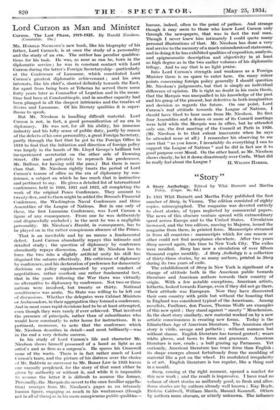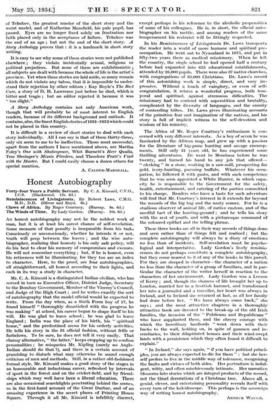"Story
Ix 1931 Whit Buinett and Martha Foley published the first number of Story, in Vienna. The edition consisted of eighty copies, mimeographed. The magazine was devoted entirely to short stories, of types neglected by commercial papers. The news of this obscure venture spread with extraordinary speed across Europe and to the United States. Circulation increased, and the two editors, moving to Majorca, issued the magazine from there, in printed form. Manuscripts streamed in from all countries : manuscripts which for one reason or other could not find acceptance elsewhere. After two years Story moved again, this time to New York City. The exiles were recalled. Story has now a circulation of over fifteen thousand copies monthly. A Story Anthology is a collection of thirty-three stories, by as many authors, printed in Story during its two years of exile.
The establishment 'of Story in New York is significant of a change of attitude both in the American public towards literature and American authors towards their country of origin. With a few notable exceptions, American artists, hitherto, looked towards Europe, even if they did not go there. Their attitude was European. Now they have discovered their own country with pride but without the boasting that in England was considered typical of the Americans. Among novelists, Faulkner, don Passos, Thomas Wolfe are examples of this new spirit ; they stand against " snooty " Menckenism. In the short story similarly, new material worked on by a new artistic consciousness is creating new forms. Today is the Elizabethan Age of American literature. The American short story is virile, savage and pathetic ; without manners but without shame. English literature has turned genteel ; wears white gloves, and bows to form and grammar. American literature is raw, crude ; a bull grazing up Parnassus. Yet curiously, American literature has truer form than English ; its shape emerges almost fortuitously from the moulding of material like a pot on the wheel. Its modulated irregularity is of art. English literature is too regular, like a thing cast in a mould.
Story, coming at the right moment, opened a market for this new work ; and the result is impressive. I have read no volume of short stories so uniformly good, So fresh and_ alive. Some stories are by authors already well known ; Kay Boyle, Erskine Caldwell, William March, Manuel- Komroff. Others by authors more obscure♦ or utterly unknown.. The influence of Tchekov, the greatest master of the short story and the worst model, and of Katherine Mansfield, his pale pupil, has passed. Eyes are no -longer fixed solely on frustration nor faith placed only in the acceptance of failure. Tchekov was the end of an age ; but not the end of the short story. A Story Anthology proves that : .it is a landmark in short story writing.
It is easy to see why some of these stories were not published elsewhere ; they violate incidentally sexual, religious or political prejudices. But none of them are exhibitionistic ; all subjects are dealt with because the whole of life is the artist's province. Yet when these stories are laid aside, so many remain which do not violate any taboo, that it is impossible to under- stand their rejection by other editors : Kay Boyle's The Rest Cure, a story of D. H. Lawrence just before he died, which is bitter and tragic ; but an editor rejected it because it was " too slight."
A Story Anthology contains not only American work, though that will probably be of most interest to English readers, because of its different background and outlook. It contains, also, the finest English stories of 1931-1933 which could not be placed in this country.
It is difficult in a review of short stories to deal with each story individually. All I can say is that of these thirty-three, only six seem to me to be ineffective. Those most successful, apart from the authors I have mentioned above, are Martha Foley's One with Shakespeare, Whit Burnett's Herr Qualla, Tess Slesinger's Missis .Flinders, and Theodore Pratt's Visit with the Master. But I could easily choose a dozen others for special mention.
A. CALDER-MARGIT AT.T.

















































 Previous page
Previous page